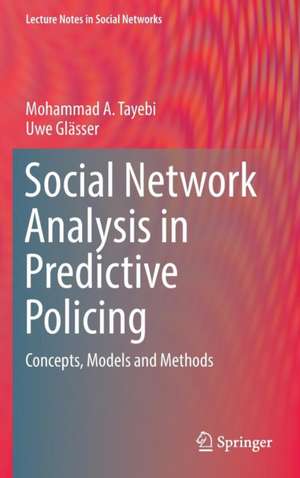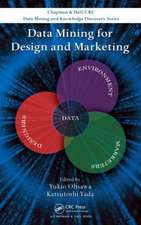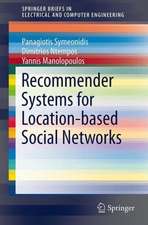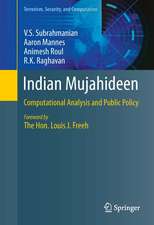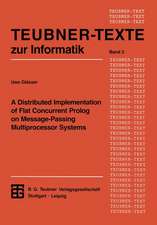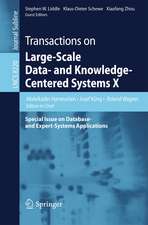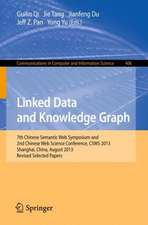Social Network Analysis in Predictive Policing: Concepts, Models and Methods: Lecture Notes in Social Networks
Autor Mohammad A. Tayebi, Uwe Glässeren Limba Engleză Hardback – 12 oct 2016
This book focuses on applications of social network analysis in predictive policing. Data science is used to identify potential criminal activity by analyzing the relationships between offenders to fully understand criminal collaboration patterns. Co-offending networks—networks of offenders who have committed crimes together—have long been recognized by law enforcement and intelligence agencies as a major factor in the design of crime prevention and intervention strategies. Despite the importance of co-offending network analysis for public safety, computational methods for analyzing large-scale criminal networks are rather premature. This book extensively and systematically studies co-offending network analysis as effective tool for predictive policing. The formal representation of criminological concepts presented here allow computer scientists to think about algorithmic and computational solutions to problems long discussed in the criminology literature. For each ofthe studied problems, we start with well-founded concepts and theories in criminology, then propose a computational method and finally provide a thorough experimental evaluation, along with a discussion of the results. In this way, the reader will be able to study the complete process of solving real-world multidisciplinary problems.
| Toate formatele și edițiile | Preț | Express |
|---|---|---|
| Paperback (1) | 638.21 lei 6-8 săpt. | |
| Springer International Publishing – 16 iun 2018 | 638.21 lei 6-8 săpt. | |
| Hardback (1) | 644.33 lei 6-8 săpt. | |
| Springer International Publishing – 12 oct 2016 | 644.33 lei 6-8 săpt. |
Din seria Lecture Notes in Social Networks
- 20%
 Preț: 655.35 lei
Preț: 655.35 lei - 20%
 Preț: 990.80 lei
Preț: 990.80 lei - 18%
 Preț: 1003.38 lei
Preț: 1003.38 lei - 18%
 Preț: 917.05 lei
Preț: 917.05 lei - 20%
 Preț: 337.52 lei
Preț: 337.52 lei - 20%
 Preț: 649.28 lei
Preț: 649.28 lei - 20%
 Preț: 996.07 lei
Preț: 996.07 lei - 15%
 Preț: 503.83 lei
Preț: 503.83 lei - 18%
 Preț: 998.66 lei
Preț: 998.66 lei - 18%
 Preț: 728.74 lei
Preț: 728.74 lei - 20%
 Preț: 991.60 lei
Preț: 991.60 lei - 18%
 Preț: 1106.00 lei
Preț: 1106.00 lei - 20%
 Preț: 668.58 lei
Preț: 668.58 lei - 5%
 Preț: 349.68 lei
Preț: 349.68 lei - 20%
 Preț: 339.14 lei
Preț: 339.14 lei - 20%
 Preț: 587.60 lei
Preț: 587.60 lei - 15%
 Preț: 644.82 lei
Preț: 644.82 lei - 20%
 Preț: 628.55 lei
Preț: 628.55 lei - 15%
 Preț: 587.72 lei
Preț: 587.72 lei - 20%
 Preț: 648.44 lei
Preț: 648.44 lei - 20%
 Preț: 570.97 lei
Preț: 570.97 lei - 20%
 Preț: 642.52 lei
Preț: 642.52 lei - 20%
 Preț: 655.02 lei
Preț: 655.02 lei - 15%
 Preț: 643.34 lei
Preț: 643.34 lei - 20%
 Preț: 764.43 lei
Preț: 764.43 lei - 20%
 Preț: 649.93 lei
Preț: 649.93 lei - 20%
 Preț: 649.60 lei
Preț: 649.60 lei - 20%
 Preț: 650.08 lei
Preț: 650.08 lei - 20%
 Preț: 889.64 lei
Preț: 889.64 lei -
 Preț: 389.11 lei
Preț: 389.11 lei -
 Preț: 395.09 lei
Preț: 395.09 lei - 20%
 Preț: 649.75 lei
Preț: 649.75 lei - 20%
 Preț: 924.56 lei
Preț: 924.56 lei - 20%
 Preț: 341.95 lei
Preț: 341.95 lei - 20%
 Preț: 992.76 lei
Preț: 992.76 lei - 20%
 Preț: 934.03 lei
Preț: 934.03 lei - 15%
 Preț: 641.03 lei
Preț: 641.03 lei
Preț: 644.33 lei
Preț vechi: 805.41 lei
-20% Nou
Puncte Express: 966
Preț estimativ în valută:
123.31€ • 133.89$ • 103.58£
123.31€ • 133.89$ • 103.58£
Carte tipărită la comandă
Livrare economică 22 aprilie-06 mai
Preluare comenzi: 021 569.72.76
Specificații
ISBN-13: 9783319414911
ISBN-10: 3319414917
Pagini: 136
Ilustrații: XI, 133 p. 43 illus. in color.
Dimensiuni: 155 x 235 x 10 mm
Greutate: 0.39 kg
Ediția:1st ed. 2016
Editura: Springer International Publishing
Colecția Springer
Seria Lecture Notes in Social Networks
Locul publicării:Cham, Switzerland
ISBN-10: 3319414917
Pagini: 136
Ilustrații: XI, 133 p. 43 illus. in color.
Dimensiuni: 155 x 235 x 10 mm
Greutate: 0.39 kg
Ediția:1st ed. 2016
Editura: Springer International Publishing
Colecția Springer
Seria Lecture Notes in Social Networks
Locul publicării:Cham, Switzerland
Cuprins
Introduction.- Social Network Analysis in Predictive Policing.- Structure of Co-offending Networks.- Organized Crime Group Detection.- Suspect Investigation.- Co-offence Prediction.- Personalized Crime Location Prediction.- Concluding remarks.- References.
Notă biografică
Dr. Uwe Glässer is a Professor of Computing Science and Dean pro tem of the Faculty of Applied Sciences, Simon Fraser University, BC, Canada. His work focuses on applied computer science, spanning three fields: industrial applications of formal methods, software technology for intelligent systems, computational criminology and security informatics. His work focuses on facilitating the human interactions that are critical in interdisciplinary research by providing the technologies and technical support to promote effective interactions.
Dr. Mohammad A. Tayebi is a Postdoc at the School of Computing Science, Simon Fraser University, BC, Canada. His general research interests are in the areas of data mining and social network analysis with focus on social computing and computational criminology fields.Textul de pe ultima copertă
This book focuses on applications of social network analysis in predictive policing. Data science is used to identify potential criminal activity by analyzing the relationships between offenders to fully understand criminal collaboration patterns. Co-offending networks—networks of offenders who have committed crimes together—have long been recognized by law enforcement and intelligence agencies as a major factor in the design of crime prevention and intervention strategies. Despite the importance of co-offending network analysis for public safety, computational methods for analyzing large-scale criminal networks are rather premature. This book extensively and systematically studies co-offending network analysis as effective tool for predictive policing. The formal representation of criminological concepts presented here allow computer scientists to think about algorithmic and computational solutions to problems long discussed in the criminology literature. For each ofthe studied problems, we start with well-founded concepts and theories in criminology, then propose a computational method and finally provide a thorough experimental evaluation, along with a discussion of the results. In this way, the reader will be able to study the complete process of solving real-world multidisciplinary problems.
Caracteristici
Presents a computational method and a thorough experimental evaluation for each problem, along with a discussion of the results Contains formal representation and algorithmic solutions of predictive policing problems Builds on extensive experience from working with law enforcement agencies Opens a new research direction in the field of computational criminology Includes supplementary material: sn.pub/extras
